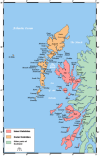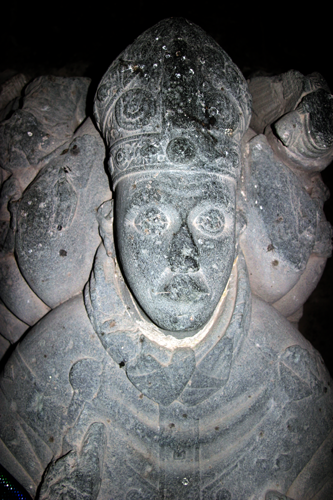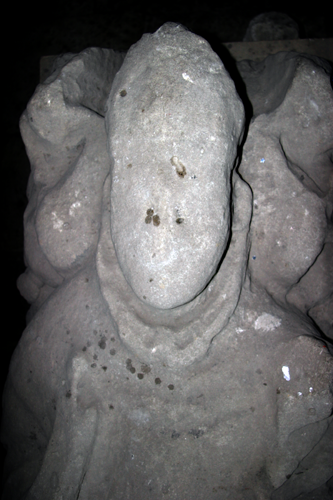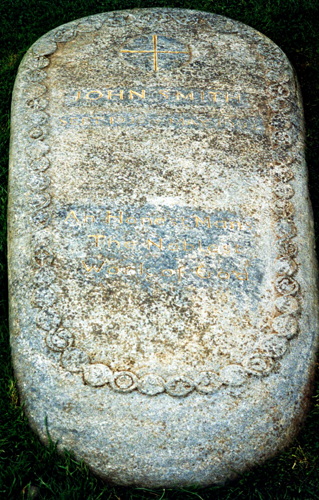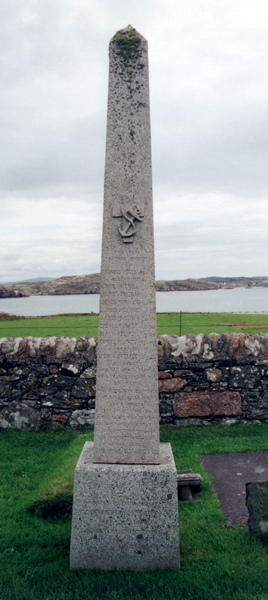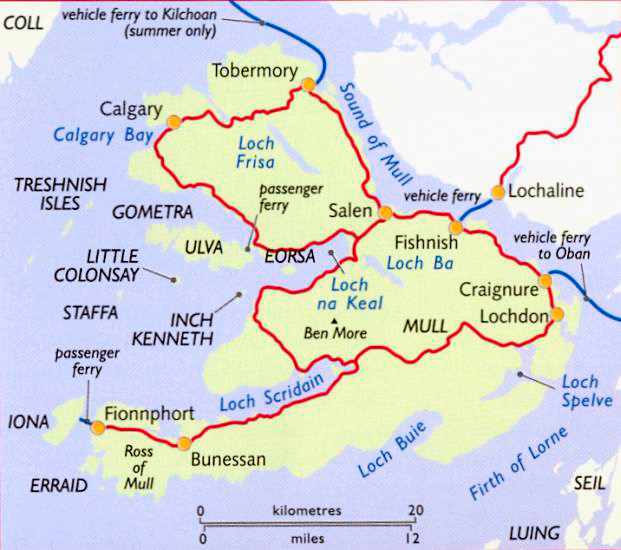 |
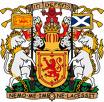 |
SCOTLAND - 1 |
 |
Unfortunately I have not been able to tour Scotland with a camera to look for monuments. Nor have a received any photographs from contributors as I have for England and elsewhere. So this is a rather meager collection. Hopefully this will change in the future. Contributions always welcome! <Scotland - 2> |
|||
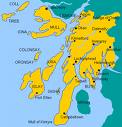 |
ARGYLL & BUTE |
 |
| Argyll and Bute is one of the new counties: the old Argyll gobbled up the southern separate old county of Bute but lost its old top northern bit to the new Highlands |
| Burial Places of the Kings of Scotland |
On the Westminster Abbey page, I added a section about the burial places of the kings and queens of first Wessex, then England and then Britain. It is a considerably easier task for those of Scotland as there are very few actual sites and virtually no monuments. Very many of the early kings were buried on Iona but if you visit Iona to see their tombs or monuments you will - like Dr Johnson - be disappointed, as there is nothing. I must add that Iona is a wonderful place to visit - and even better to stay - despite this comment. There are a number of interesting monuments however but none of any kings or their consorts. All the kings of Scotland from Kenneth MacAlpin (reigned c. 841 - c. 859), who may be considered the founder of the Scottish nation, with few exceptions until, possibly, Duncan II (reigned 1094) were buried on Iona in the Reilig Odháin, and this list includes one who is the most famous, the unfortunate MacBeth -1. However there appear to be no tombs and there are certainly no monuments there. Some effigies, which were often said to be of kings, were sited there, although have now been moved into the abbey museum, were later and of local chieftains. The exceptions were: 1. Constantine II (952), who was buried at the monastery at St Andrews, where he had retired; 2. Malcolm III (1031-1093) See Below -2. 3. Duncan II (1060-10940 Uncertain, possibly Iona or Dunfermline. 4. Edmund (1097) Uncertain. He was forcibly retired to English monastery at Montacute Somerset . 5. Edgar (1074-1107) Dunfermline. 6. Alexander I (1077-1124) Dunfermline. 7. David I (1080-1153) Dunfermline 8. Malcolm IV (1142-1165) Dunfermline 9. William the Lion (1143-1214) Arbroath Abbey. There is a headless effigy found during excavation on display in the museum. 10. Alexander II (1198-1249) Melrose Abbey. 11. Alexander III (1241-1268) Dunfermline. 12. Margaret (1283-1290) 'The Maid of Norway'. Kristkirken Cathedral, Bergen, Norway which was demolished in 1530. 13. John Balliol (1250-1296) died in exile in Normandy. Buried in the church of St Waast, Bailleul but the church was destroyed in Word War I. 14. Robert I (Bruce) (1274-1329) Dunfermline. All the monuments were destroyed at the Reformation but his skeleton was discovered in a vault in 1818. After a detailed re-examination the following year, the remains were reburied in a new coffin and a porphyry slab with a brass image of the King was unveiled over the vault in 1889. 14.David II (Bruce) (1324) Holyrood Abbey 15. Edward (Balliol) (1363) He died at Wheatley, near Doncaster, Yorkshire may have been buried in the Church of St George there but there is no further information. The following are members of the House of Stewart: 16. Robert II (1316-1390) Scone Abbey, Perthshire, now largely destroyed. 17. Robert III (1337-1406) Paisley Abbey, Renfrewshire. The monument was destroyed at the Reformation but a new one was constructed on the orders of Queen Victoria in 1888. 18. James I (1394-1437) The Chapterhouse at Perth, now destroyed. A marble slab formerly bearing a brass depicting a couple which may be part of the tomb was later discovered and is now in St John's Perth 19. James II (1430-1460) Holyrood Abbey. James III (1452-1488) Cambuskenneth Abbey, Sterling. The church and tomb were destroyed at the Reformation. During excavations in 1864 a blue limestone slab with a brass indent and an oak coffin with a skeleton below. The remains were buried in a new table tomb in the grounds of the former abbey. 20. James IV (1473-1513) See below -3 . 21. James V (1512-1542). See below -4 22. Mary Stuart, Queen of Scots (1542-1567) was executed at Fotheringay, Northamptonshire and buried in Peterborough Cathedral. Her body was transferred to Westminster Abbey by her son, James I and VI and a magnificent monument constructed over her vault. - 1 Unfortunate for two reasons: he was killed in battle after a peaceful reign of fourteen years and secondly, Shakespeare wrote a play about him. This play- even if you remove the silly or naïve bits, such as chanting witches, man not born of woman, and moving woods - does not even approach the true life of the King. Unfortunately people tend to learn their history from Shakespeare, as well as films and television programmes: even if you type MacBeth in Google, MacBeth the play will appear before MacBeth the King. This is very regrettable. -2 He was buried with his son, Edward, at the priory of Tynemouth, following their death in battle in Northumbria. It is said that during the reign of Alexander I their bodies were removed from Tynemouth for burial in Dunfermline by the side of Malcolm's wife, Queen Margaret. However two skeletons were found at Tynemouth in 1247 which were thought to be those of Malcolm and his son and were given new tombs in the church. The supposed remains of Malcolm (or whatever was taken by Alexander I) were moved next to his wife, now St Margaret, in Dunfermline. An easter extension had been built to house a shrine for St Margaret; however her body miraculously refused to be moved past Malcolm's in the procession to the extension. So Malcolm 's body came to lie in the extension next to that of his wife. After destruction of the eastern arm and the shrine in 1560 some remains were said to have been acquired by Philip II of Spain who placed them in two urns in the church of his palace only to be disturbed during the French occupation. Bishop James Gillis (Scottish Roman Catholic bishop) applied to the pope for their return to Scotland but they could not be identified. -3 James IV was killed at the Battle of Flodden by the English armies when he invaded England. His body was identified and taken to Berwick where it was embalmed and placed in a lead coffin. It was then sent to England where it was received by Queen Catherine of Aragon, King Henry VIII then being in France. Queen Catherine sent King James's slashed and bloody surcoat to her husband and suggested it be used as a war banner. James's body was taken to the Charterhouse at Sheen, near Richmond. However he was denied Christian burial having been been excommunicated by the Pope, ostensibly because he had broken the Truce of Perpetual Peace between Scotland and England in 1502, sealed by the marriage of King James to Henry's sister Margaret, when he invaded England, but in reality because James supported France, who were then at war with the papacy, and the Pope was hoping for help from the English King. Not an inspired hope as the King was Henry VIII! So King James was kept in the woodshed. At some point his coffin was opened and the head detached, either by willful decapitation or simple by advancing decay. The head was probably stolen and it is reported that it was eventually buried in St Michael's Church, Wood Street, City of London. This church was demolished in 1879 but the head was not found. A public house was built over the site: it is not called The King's Head. The fate of King James's body is not reported. A sorry end for the most attractive member of a far from attractive dynasty. -4 Holyrood Abbey was founded by King David I, although he was buried in Dunfermline Abbey, the second Scottish Royal mausoleum following Iona; Holyrood was to become the third. The first king to be buried there was the founder's namesake, King David II (Bruce). Members of the Scottish royal family were then mostly buried in the Abbey Church, the last being Henry Stuart, Lord Darnley, the unsatisfactory second husband of Mary Queen of Scots, in 1567. The accounts of the burials are not clear but here is an attempt to piece it all together. One source says the burials took place in a vault in east bay of the south aisle of the nave; this probably refers to the present vault which was not built until the sixteenth century and long after the first burials. This is probably a misinterpretation and the bodies were more likely separately buried in thequire. However the body of James V (1542) certainly appears to have been buried in a separate grave in the Abbey quire, as will be shown. The Abbey was sacked by an English army under Edward Seymore, Duke of Somerset (Protector during early part of reign of Edward VI and brother to Queen Jane) in 1547 when (and according to a plaque on the wall of the present vault) the quire, crossing and transepts were destroyed. The royal tombs were also destroyed, which further suggests they were in the quire, and the present vault built. Presumably James V's grave was also opened because in the reign of his son his body was re-embalmed and moved to a new vault in the nave; this was presumable a different vault to the one mentioned above. This latter vault was accidentally discovered in 1683 and his body examined. In 1687 James VII & II introduced Roman Catholic fittings in the Abbey Church which led to an attack by a Protestant mob who broke into the vault and scattered the bones, this included the body of James V. The plaque on the vault wall today states that the vault 'had the remains of James V, Magdalen (his first wife) and an infant son of his second wife (Mary of Guise) and it also contains the coffin of Mary of Guelders, Queen of James II, which was transferred from Trinity Church, Edinburgh in 1848)'. There is here no mention of other burials. In 1758 there was an attempt to re-roof the Abbey Church but the roofing stones proved too heavy for the supporting timbers and the roof collapsed. In 1768 James V's coffin was stolen for its lead and his bones added to the others in the vault. In 1898 Queen Victoria ordered the repair of the vault when all the remains therein were collected and buried in one coffin on a top shelf. More details of Scottish tombs may be found in The Royal Tombs of Great Britain by Aidan Dodson (Duckworth 2004). I acknowledge the book here as being very useful in filling gaps in my knowledge of Scottish royal tombs. |
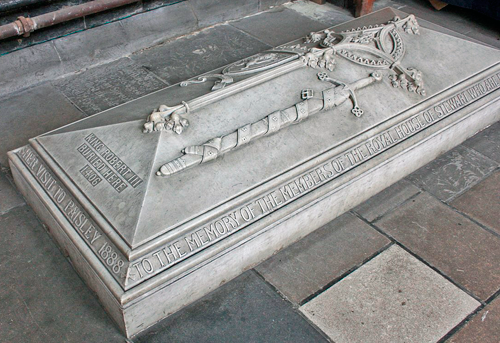 |
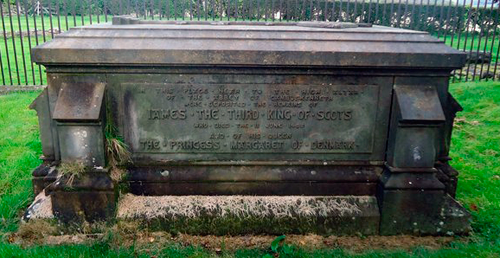 |
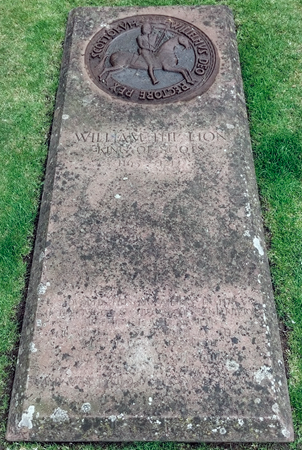 |
| Left:
King Robert III Victorian monument at Paisley
Abbey By Stephencdickson - Own work, CC BY-SA 4.0, https://commons.wikimedia.org/w/index.php?curid=62007378 Above: King James III Victorian monument in the yard of Cambuskenneth Abbey By Robert Murray. Used under terms of licence Right: Modern monument over the grave of King William the Lion in the ruined Arbroath Abbey. |
| Above is shown the modern
monument of William the Lion with a brass based on the King's
seal, and. which
is placed over the likely site of the King's grave in Arbroath
Abbey. It is interesting to compare this 20th century monument
to its Victorian counterparts on the left, all of which mark the
burial sites of Scottish Kings. As this part of the ruined abbey is roofless this monument is exposed to the elements. When I first visited Arbroath an effigy of the was placed in this position but this (with one of an abbot) have been quite rightly placed in the (roofed) Abbey Museum. Images of these two monuments may be seen on Scotland 2 I always think that it is rather curious that France - once a monarchy but now a long time republic - has an excellent series of royal monuments. England, a monarchy - but a republic for a very short period - has a much poorer collection. Scotland - who crowned the son of King Charles I as Charles II and provoked an invasion from Republican England for their pains - has virtually nothing at all. |
 |
 |
Isle of Iona |
 |
 |
| Take the
Caledonia-MacBrayne - either vehicle or pedestrian - ferry from
Oban (on the West Coast) to Craignure on the Island of Mull.
From here either drive or take the bus, along the southern coast
of Mull to Fionnphort. You must park here as no vehicles are
allowed on Iona, except those of the Islanders. A car is hardly
needed anyway so this is little problem. The take the pedestrian ferry to Iona. Travelling on the
'Calmac' ferries - delightfully referred to 'steamers' - is
much cheaper if you take a sheep with you. Gaelic name meaning, possible, Yew Place |
There are four sites where monuments can be found on Iona: the restored Abbey and its outbuildings (left), the ruined Nunnery (near right), St Oran's chapel (far right) and the ancient graveyard - the Reiglig Odhrain - part of which may be seen in this latter photograph.
| Iona Abbey O/S Ref: NM 286 245 |
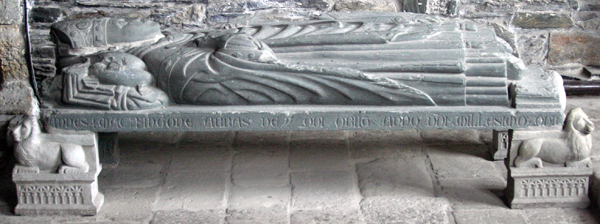 |
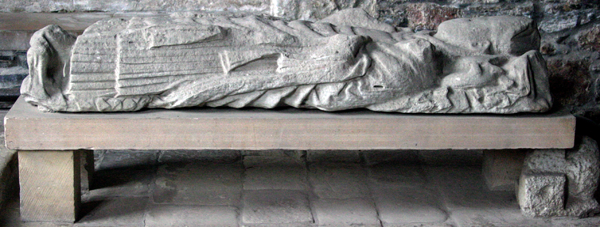 |
||||||
|
|||||||
Below are a number of monuments now in the Abbey museum; they were taken from several exposed sites into the museum for protection from the weather. I remember some being in the Reilig Odrain in about 1970 |
|||||
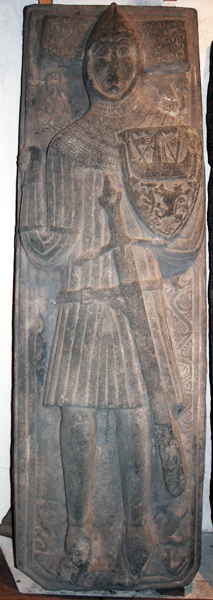 |
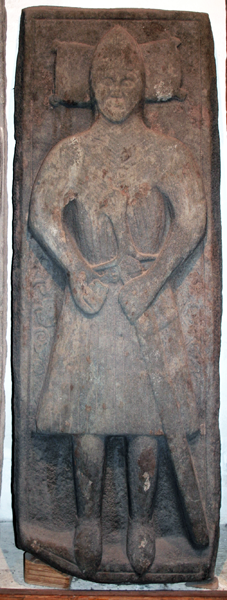 Latin
i Latin
i |
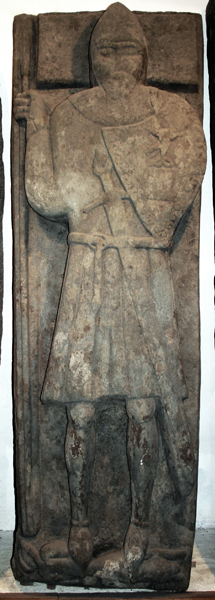 |
.
 |
 |
 |
Above from left to right: 1)[207/108] Gilbride, a chief of the MacKinnons. Latin inscription on the pillow: Here lies Gilbride MacKinnon with his sons Ewan and Corbellus. (Formerly in St Oran's Chapel). 2) [209/100] Unknown. (Formerly in Reilig Odrain). 3) [210/99] Unknown. (Formerly in Reilig Odrain). 4) [211/10] Unknown. An inscription down the left side of the slab reads: ...of Lachan ...and Mael-Sechlainn Ó Cuinn, mason fashioned it. (Formerly in Reilig Odrain). 5) [208/98] Unknown. Note the whelk shell attached to his belt on his right; this may have been used as a hunting horn. The bad fracture through the head was caused by 19th century vandalism (Formerly in Abbey Church) 6) [214/93] The inscription reads: This is the cross of Lachlan MacKinnon and his son John, Abbot of Iona, made in the year of Our Lord 1489. Lachlan was the Chief of the MacKinnon clan and his son John was the Abbot whose effigy is above. This is the base of a cross and may not actually be a church monument as such. (Formerly in St Oran's Chapel) |
|||||
 |
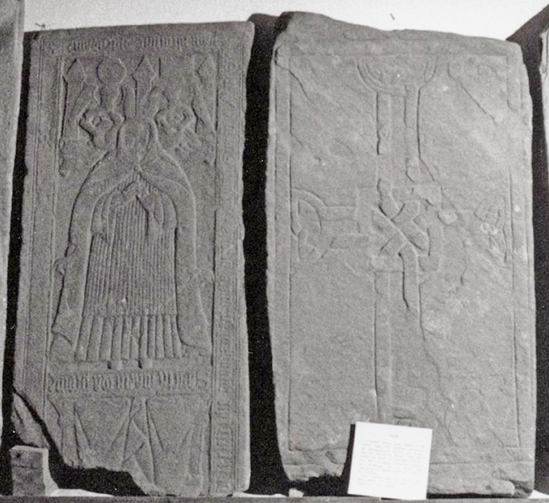 |
 |
| Drawing of the undamaged graveslab of Prioress Anna MacClean (see right) made before the collapse of the Nunnery roof. The details decribed next may be more clearly seen. | Above left: [204/105] Prioress Anna MacClean. Fragment in very low relief, which was broken
by the collapse of the Nunnery roof about 1830.
The lower half contained the
figure of the Virgin Mary. They
are curiously arranged like a face card. Latin
inscription, partly lost: Here lies lady Anna, daughter of
Donald, son of Charles, sometime
Prioress of Iona who died in the
year 1543. We comment her soul
to the All-Highest... Note
these features: her head rests on a pillow which is
supported by two angels with three turrets in the background
between which are a mirror and a comb; a pair of dogs rest on
her cloak. ( Formerly
in the Nunnery). Above right: Very little remains of the inscription: R_ _ O_ C (Formerly in Reilig Odrain) |
Above left: [45/40]
Éogan. The
inscription in Old Irish reads: A prayer for the soul of
Éogan. Possibly eighth century.
(Formerly in Reilig Odrain) Above right: [46/38] Possibly Abbot Flann mac Maíle-dúin (891) The inscription in Old Irish reads: A prayer for the soul of Flann. (From the pavement in front of 'St Columba's Shrine'.) |
 |
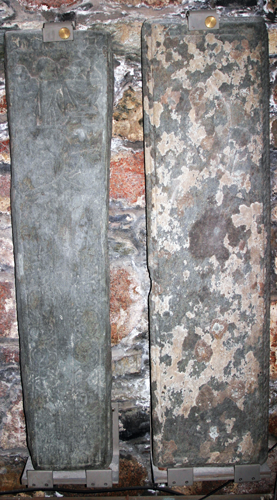 |
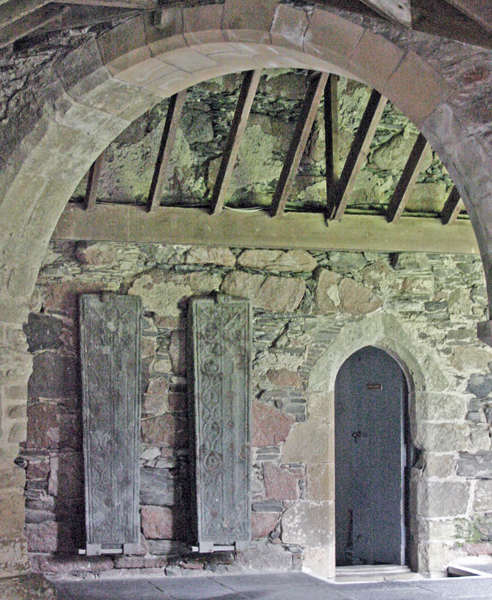 |
|
Above: There are a number of stones - many very worn - which have been set up in the Abbey cloisters |
|||
| St Oran's chapel and the Reiglig
Odhrain [12] O/S Ref: NM 286 244 |
St Oran's Chapel has a few flat stones, most of the monuments from there and the Reiglig Odhrain having been moved to the Abbey museum. The Reiglig Odhrain is said to have been the burial site of sixty of kings and chieftains, as well as Egfrith of Northumbria (685) [Ref: Symeon of Durham] and Irish and Scandinavian kings [Ref: Chronicle of the Kings and others]. There are no monuments to any so you will feel as disappointed as Dr Johnson should you pay a visit. The list of burials may be found here. There is a tomb recess in the Chapel and the Reiglig Odhrain contains a number of modern monuments, two which may be interest are shown below. |
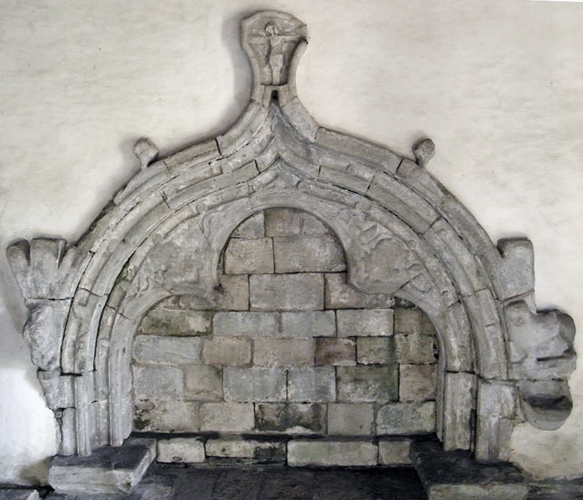 Left: Tomb recess in St
Oran's Chapel. Some of the detail
is impossible to see in a photograph of this size so the
following description is based on the details from an excellent
drawing in the RCHM volume. The surround is of two orders: the
inner forming a round headed trefoil arch whereas the outer is
formed by an
ogee arch. Left: Tomb recess in St
Oran's Chapel. Some of the detail
is impossible to see in a photograph of this size so the
following description is based on the details from an excellent
drawing in the RCHM volume. The surround is of two orders: the
inner forming a round headed trefoil arch whereas the outer is
formed by an
ogee arch.The spandrels of the inner arch is carved with horned beasts with protruding tongues, clawed feet and with tails split into leaf sprays. At the apex is a green man. One cusp terminal survives, consisting of a rosette surrounded by foliage. The outer surround features a carve head with mitre. On its outer aspects are carved two edge rolls with nail head carving between. The outer roll continues at the apex to surround a panel bearing a carving of the Crucified Christ. Both orders feature series of peterae carved with human heads, rosettes, quatrefoils, leaf sprays and geometric patterns. The hood springs from lion on the west side which also supports a pinnacle; it also carries on a broken basin. That on the east springs from a carved figure from which spring the hood mounding intended for a second, never completed tomb. This work is probably later fifteenth century but there is no indication for whom it was constructed. John, First Lord of the Isles (1387) and Donald, Second Lord (1421), are said to have been buried in this part of the chapel. Angus Ògg (1490), son of the Fourth Lord and Abbey benefactor may have begun the two tombs for himself and predecessors. Another candidate is Abbot John MacKinnon for his own family. |
|
| The Nunnery O/S Ref: NM 284 240 |
The nunnery has a number of worn cross slabs ; one slab with low relief effigy as been moved to the Abbey museum. |
| St Kilninian O/S Ref: NM 397 457 |
| St Kilninian's church [305]
dates from 1755 but probably occupies the site of a medieval
church. It is now a Romanian Orthodox
Church. The Post code is PA74 6NH. The website says that opening
is 'by arrangement'. However the church may be contacted
via the
website |
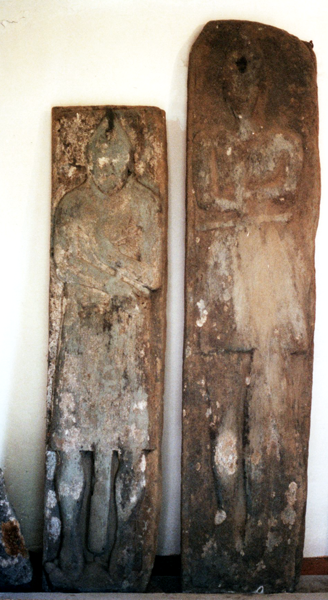 |
Above left: [7] Slab with man wearing a pointed bascinet and aketon; he carries a claymore. His head rest on a cushion and his feet a hound. Early 16th century Above right: [8] Possibly a smith in helmet and tunic, grasping a claymore. An anvil is between his feet. Late 16th-17th century. There are several slabs in the church. When the RCHMS visited in the 1970's all of the monuments were in the church yard; they had been brought into the church by the time we visited in the early 2000's. The photograph of 7 is far clearer in the RCHM's photograph and I am only guessing that 8 is that which the RCHM describes. |
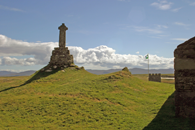 |
Oronsay Priory O/SRef: NR 349 886 |
 |
| A visit to Oronsay Priory is
recommended but only for the fit enthusiast! Oronsay is
a small island off the West Coast with a population of
eight in 1991. Take the ferry from Oban to Scalasaig on
the nearby Island of Colonsay, where you may stay the
night. Follow the B8086 from the ferry
east, turn left (south) on the B8055, a distance of
about three miles - either on foot or take the post bus
- to The Strand which separates the two islands. The
Strand, about a mile in length, can be crossed at low
tide by foot on a designated path and it is then about a
mile's walk to the priory. The ruins are delightful,
second only to Iona. There are over thirty medieval
monuments - both carved stones and effigies - which are
now
housed in roofed building. The name is Norse meaning Oran's Island or Ebb Island |
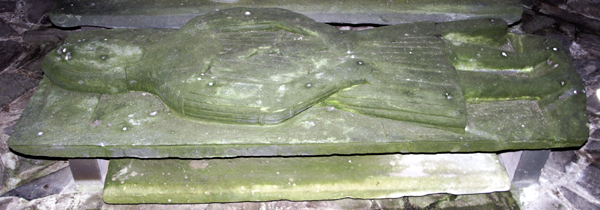 |
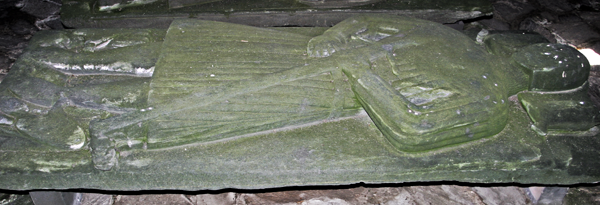 |
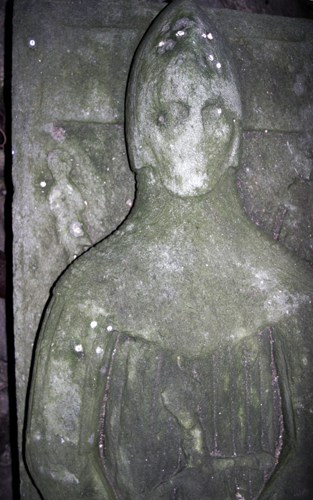 |
 |
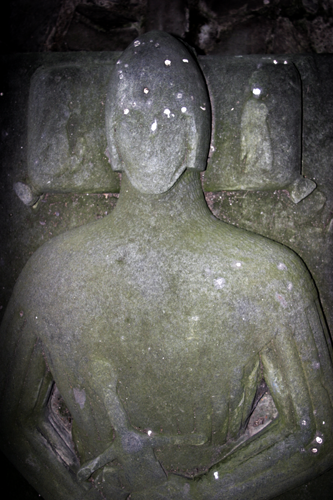 |
|
| Above and above this:
[21] Effigy
in
medium relief. He wears a bascinet and aventail and an aketon.
His head rests on a pillow and there are figures either side of
the neck and shoulders: a winged figure on one and St Michael
weighing souls on the other. 14th - 15th century. Right [28] Effigy in low relief and very worn. Here there is a raised margin around the slab which may have borne an inscription. He wears a bascinet with aventail and aketon. His head rests on a pillow borne by angels and his feet rest on an animal. Below is a galley. 1500-1560 |
Above and above this:
[22] Effigy in moderately low relief.
The armour resembles that of 21 but with richer detail. There
are two winged figures but this time on the pillow: on the one side
holding a book and on the other St Michael standing on a dragon.
Flanking the feet are two figures wearing cloaks over long
robes. 14th-15th century. There are many more stones, some with effigies. They appeared much more worn in the early 2000's than those shown in the RCHM 's photographs of the 1980's |
The Royal Tombs of Great Britain by Aidan Dodson (Duckworth 2004)
The Tombs of the Kings: An Iona Book of the Dead by John Marsden (Llanerch Publishers 1994) This book examines the original sources for the burials on Iona
